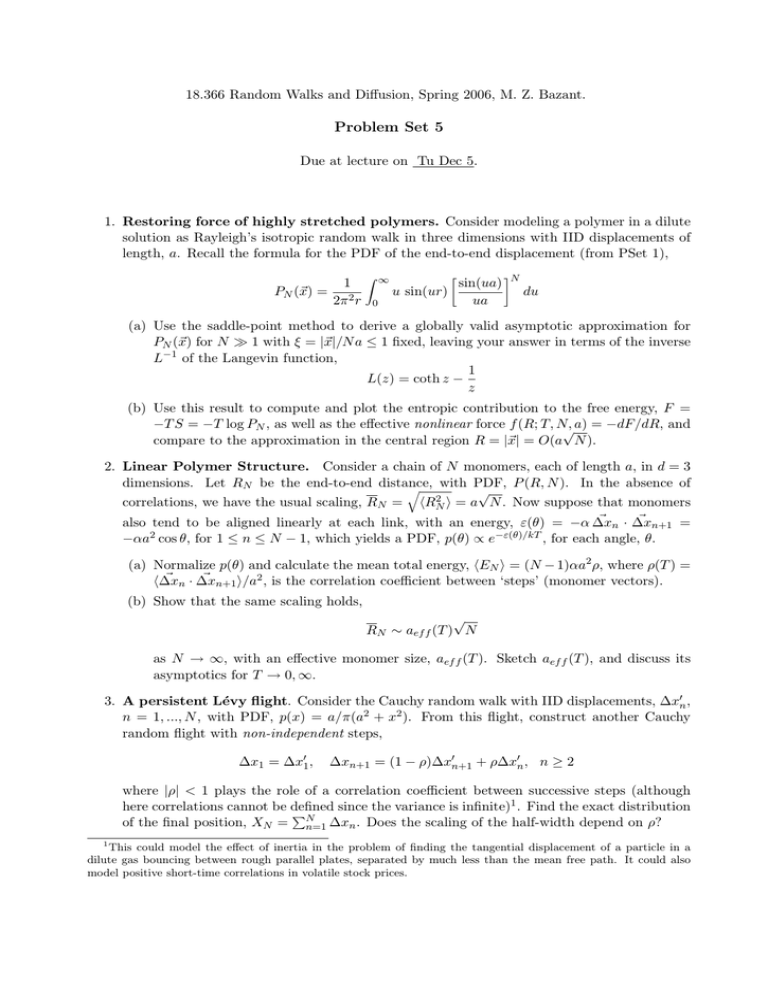Problem Set 5
advertisement

18.366 Random Walks and Diffusion, Spring 2006, M. Z. Bazant. Problem Set 5 Due at lecture on Tu Dec 5. 1. Restoring force of highly stretched polymers. Consider modeling a polymer in a dilute solution as Rayleigh’s isotropic random walk in three dimensions with IID displacements of length, a. Recall the formula for the PDF of the end-to-end displacement (from PSet 1), PN (�x) = 1 2π 2 r � ∞ � u sin(ur) 0 sin(ua) ua �N du (a) Use the saddle-point method to derive a globally valid asymptotic approximation for PN (�x) for N � 1 with ξ = |�x|/N a ≤ 1 fixed, leaving your answer in terms of the inverse L−1 of the Langevin function, 1 L(z) = coth z − z (b) Use this result to compute and plot the entropic contribution to the free energy, F = −T S = −T log PN , as well as the effective nonlinear force f (R; T, N, √a) = −dF/dR, and compare to the approximation in the central region R = |�x| = O(a N ). 2. Linear Polymer Structure. Consider a chain of N monomers, each of length a, in d = 3 dimensions. Let RN be the end-to-end distance, with PDF, P (R, N ). In the absence of � √ 2 correlations, we have the usual scaling, RN = �RN � = a N . Now suppose that monomers also tend to be aligned linearly at each link, with an energy, ε(θ) = −α Δ�xn · Δ�xn+1 = −αa2 cos θ, for 1 ≤ n ≤ N − 1, which yields a PDF, p(θ) ∝ e−ε(θ)/kT , for each angle, θ. (a) Normalize p(θ) and calculate the mean total energy, �EN � = (N − 1)αa2 ρ, where ρ(T ) = �Δ�xn · Δ�xn+1 �/a2 , is the correlation coefficient between ‘steps’ (monomer vectors). (b) Show that the same scaling holds, √ RN ∼ aef f (T ) N as N → ∞, with an effective monomer size, aef f (T ). Sketch aef f (T ), and discuss its asymptotics for T → 0, ∞. 3. A persistent Lévy flight. Consider the Cauchy random walk with IID displacements, Δx�n , n = 1, ..., N , with PDF, p(x) = a/π(a2 + x2 ). From this flight, construct another Cauchy random flight with non-independent steps, Δx1 = Δx�1 , Δxn+1 = (1 − ρ)Δx�n+1 + ρΔx�n , n ≥ 2 where |ρ| < 1 plays the role of a correlation coefficient between successive steps (although here correlations cannot be defined since the variance is infinite)1 . Find the exact distribution � of the final position, XN = N n=1 Δxn . Does the scaling of the half-width depend on ρ? 1 This could model the effect of inertia in the problem of finding the tangential displacement of a particle in a dilute gas bouncing between rough parallel plates, separated by much less than the mean free path. It could also model positive short-time correlations in volatile stock prices. 4. A continuous-time random walk. Derive the exact PDF of the position, PN (n, t), of an unbiased CTRW on the integer lattice n = 0, ±1, ±2, ... starting at the origin (with nearestneighbor hopping) with waiting time PDF, ψ(t) = e−t . 5. Self-Avoiding Walk. (Extra credit) Simulate self-avoiding walks on a cubic lattice in three­ dimensions2 , and try to determine the scaling of the root-mean-square end-to-end length Rn =< |X�N |2 >1/2 ∼ N ν by plotting log RN versus log N and getting the slope of a (hopefully) straight line. How does your result compare with the Fisher-Flory estimate ν = 3/(d + 2) = 3/5 and the recent numerical result 0.5877 ± 0.0006? 2 It is nontrivial to generate large SAW (because most end up “trapped”), so to see the scaling above, you may need to think about more sophisticated sampling algorithms!






